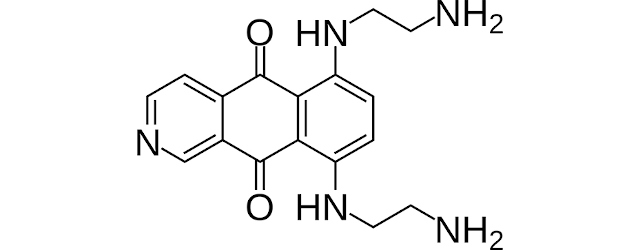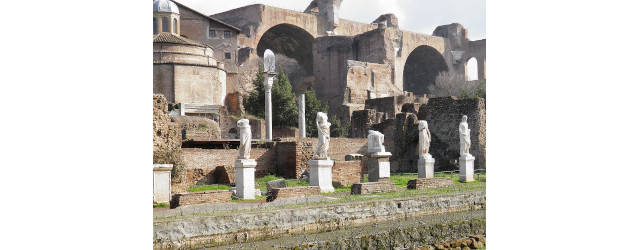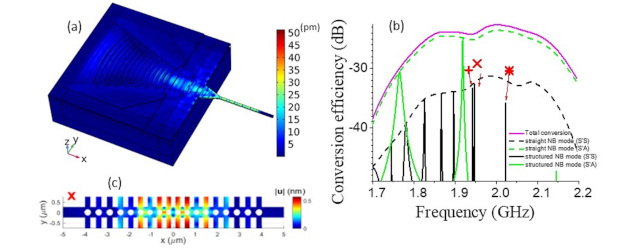Validity of the Silver-Blaze property for QCD at finite chemical potential (Vol. 51, No. 1)

The properties of the theory of strong interactions, QCD, at finite chemical potential are of great interest for at least two reasons: (i) model studies suggest a potentially rich landscape of different phases with highly interesting analogies to those found in solid state physics; (ii) the resulting thermodynamic properties have far reaching consequences for the physics of neutron stars and neutron star mergers. Investigating the properties of light scalar and pseudo-scalar quark-antiquark bound states at finite chemical potential by solving coupled sets of Dyson-Schwinger equations , the meson masses, wave functions, and decay constants are computed, as well as changes in the quark dressing functions for chemical potentials below the first-order chiral phase transition while tracing charge-conjugation parity breaking. Eventually, we confirm the validity of the Silver-Blaze property: in observables all dependencies of colored quantities (propagators, wave-functions, etc.) on chemical potential cancel out and we observe constant masses and decay constants up to and into the coexistence region of the first-order chiral phase transition.
Pascal J. Gunkela, Christian S. Fischerb, and Philipp Isserstedtc, Quarks and light (pseudo-)scalar mesons at finite chemical potential, Eur. Phys. J. A 55, 169 (2019)
[Abstract]
Determining the shapes of atomic clusters (Vol. 51, No. 1)

By considering the crystal structures of atomic clusters in new ways, researchers may be able to better assess whether the groups have distinctive shapes, or whether they are amorphous.
Too large to be classed as molecules, but too small to be bulk solids, atomic clusters can range in size from a few dozen to several hundred atoms. The structures can be used for a diverse range of applications, which requires a detailed knowledge of their shapes. These are easy to describe using mathematics in some cases; while in others, their morphologies are far more irregular. However, current models typically ignore this level of detail; often defining clusters as simple ball-shaped structures. In research published in EPJ B, José M. Cabrera-Trujillo and colleagues at the Autonomous University of San Luis Potosí in Mexico propose a new method of identifying the morphologies of atomic clusters. They have now confirmed that the distinctive geometric shapes of some clusters, as well as the irregularity of amorphous structures, can be fully identified mathematically.
J.M. Cabrera-Trujillo, J.M. Montejano-Carrizales, C.G Galván, Amorphicity and Structural Changes in Binary Clusters, Eur. Phys. J. B 92, 237 (2019)
[Abstract]
Inhibitory neurons retrieving physical properties from two-colour laser experiments (Vol. 51, No. 1)

Useful information about ultrafast light-matter interactions is buried deep in the signals produced by two-colour pump-probe experiments, and requires sophisticated techniques to disentangle it.
When photons of light interact with particles of matter, a diverse variety of physical processes can unfold in ultrafast timescales. To explore them, physicists currently use ‘two-colour pump-probe’ experiments, in which an ultrashort, infrared laser pulse is first fired at a material, causing its constituent electrons to move. After a controllable delay, this pulse is followed by a train of similarly short, extreme-ultraviolet pulses, ionising the material. By measuring the total ionisation following the pulses along with the resulting electron energy spectra, physicists can theoretically learn more about ultrafast, light-matter interactions. In new research published in EPJ D, an international team of physicists, led by Eric Suraud at the University of Toulouse, discovered that these signals are in fact dominated by the less interesting interplay between electrons and the initial infrared laser. They show that more useful information is buried deeper within these signals.
T. Brabec, P. M. Dinh, C. Z. Gao, C. R. McDonald, P-G. Reinhard, E. Suraud, Physical mechanisms encoded in photoionization yield from IR+XUV setups, European Physical Journal D 73, 212 (2019)
[Abstract]
Advanced cancer drug shrinks and intercalates DNA (Vol. 51, No. 1)

Experiments and statistical models reveal that the recently developed cancer drug Pixantrone forces itself inside the double helix structure of DNA molecules, then shrinks their backbones.
Because of the harmful side-effects of chemotherapy, and the increasing resistance to drugs found in many cancer cells, it is critical for researchers to continually search for new ways to update current cancer treatments. Recently, a drug named Pixantrone (PIX) was developed, which is far less damaging to the heart than previous, less advanced compounds. PIX is now used to treat cancers including non-Hodgkin’s lymphoma and leukaemia, but a detailed knowledge of the molecular processes it uses to destroy cancer cells has been lacking so far. In a new study published in EPJ E, Marcio Rocha and colleagues at the Federal University of Viçosa in Brazil uncovered the molecular mechanisms involved in PIX’s interactions with cancer DNA in precise detail. They found that the drug first forces itself between the strands of the DNA molecule’s double helix, prising them apart; then compacts the structures by partially neutralising their phosphate backbones.
C.H.M. Lima, J.M. Caquito jr, R.M. de Oliveira, M.S. Rocha, Pixantrone anticancer drug as a DNA ligand: Depicting the mechanism of action at single molecule level, Eur. Phys. J. E 42, 130 (2019)
[Abstract]
Unpacking the mystery of Feynman’s reference amplifier (Vol. 51, No. 1)

A review of lectures given by Feynman between 1946 and 1971 showcase the strong influence that his involvement in the Manhattan Project held on his research, while revealing an intriguing mystery surrounding one particular amplifier device.
Richard Feynman was one of the 20th century’s most celebrated physicists. In 1943, he began his career in the Manhattan Project, where one of his tasks was to develop a device which could count the neutrons produced by nuclear reactions. Neutron signals emerging from counters must be strongly amplified to achieve this, but in the 1940s, practical amplification devices were hindered by their distorted signals. To overcome the issue, Feynman proposed a theoretical ‘reference amplifier’, which could provide amplifiers with a standard signal to be compared with. Through analysis published in EPJ H, researchers at the University of Naples, Italy, propose that this line of research exemplifies the influence which Feynman’s involvement in the Manhattan Project held over his later teaching and research.
V. d’Alessandro, S. Daliento, M. Di Mauro, S. Esposito, A. Naddeo, Searching for a response: the intriguing mystery of Feynman’s theoretical reference amplifier, European Physical Journal H 44, 331 (2019)
[Abstract]
Cell motility in a compressible gel (Vol. 51, No. 1)

Cell motility is crucial to biological functions ranging from wound healing to immune response. Spontaneous movement and deformation are physically driven by the cell cytoskeleton.
The cytoskeleton consists of protein filaments and motors which constantly consume chemical energy (ATP) and convert it to work. In particular, actin filaments interact with myosin motors to generate contraction forces in the cell, which drive cell motion and division. Most of the research has focused, both experimentally and theoretically, on cell migration on a two-dimensional substrate (crawling), providing a detailed outline of some basic migration mechanisms. However, some cells, such as breast tumor cells, can also “swim” in a straight line inside a 3D tissue or a polymeric fluid, in the absence of substrates. The authors present a minimal model for pattern formation within a compressible actomyosin gel, which is numerically solved both in 2D and 3D. Contractility leads to the emergence of an actomyosin droplet within a low-density background. This droplet then becomes self-motile for sufficiently large motor contractility. Simulations also show that compressibility has the effect to facilitate motility, as it decreases the value of the isotropic contractile stress beyond which the droplet starts to move.
G. Negro et al, Hydrodynamics of contraction-based motility in a compressible active fluid, EPL 127, 58001 (2019)
[Abstract]
Science reveals improvements in Roman building techniques (Vol. 51, No. 1)

A variety of scientific techniques have been combined to highlight improvements in the technologies employed by the Romans in successive modifications to the Atrium Vestae in Rome.
The Romans were some of the most sophisticated builders of the ancient world. Over the centuries, they adopted an increasingly advanced set of materials and technologies to create their famous structures. To distinguish the time periods over which these improvements took place, historians and archaeologists typically measure the colours, shapes and consistencies of the bricks and mortar used by the Romans, along with historical sources. In new research published in EPJ Plus, Francesca Rosi and colleagues at the Italian National Research Council improved on these techniques through scientific analysis of the materials used to build the Roman Forum’s Atrium Vestae. They found that successive phases of modification to the building saw improvements including higher quality raw materials, higher brick firing temperatures, and better ratios between carbonate and silicate building materials.
E Boccalon, F Rosi, M Vagnini, A Romani, Multitechnique approach for unveiling the technological evolution in building materials during the Roman Imperial age: the Atrium Vestae in Rome, Eur. Phys. J. Plus 134, 528 (2019)
[Abstract]
Multiple magnon modes in a magnetic Weyl semimetal (Vol. 51, No. 1)

An area of interest in condensed matter physics is topological Weyl semimetals (WSMs). There are only a few candidates of magnetically ordered materials for the realisation of WSMs, like the kagome-lattice ferromagnet Co3Sn2S2.
Novel magnon branches are predicted in magnetic Weyl semimetals, which can be understood as a result of the coupling between two magnetic moments mediated by Weyl fermions. Here, we experimentally investigate electron transport in the kagome-lattice ferromagnet Co3Sn2S2, which is regarded as a time-reversal symmetry broken Weyl semimetal candidate. We demonstrate dV/I(I) curves with pronounced asymmetric dV/dI spikes, similar to those attributed to current-induced spin-wave excitations in ferromagnetic multilayers. In contrast to multilayers, we observe several dV /dI spikes’ sequences at low, ≈104 A/cm2 , current densities for a thick single-crystal Co3Sn2S2 flake in the regime of fully spin-polarised bulk. The spikes at low current densities can be attributed to novel magnon branches in magnetic Weyl semimetals, which are predicted due to the coupling between two magnetic moments mediated by Weyl fermions. The presence of spin-transfer effects at low current densities in Co3Sn2S2 makes the material attractive for applications in spintronics.
O. O. Shvetsov et al, Multiple magnon modes in the Co3Sn2S2Weyl semimetal candidate, EPL 127, 57002 (2019)
[Abstract]
Focusing surface acoustic waves into an optomechanical nanobeam (Vol. 51, No. 1)

Cavity optomechanics (OM) is a topical issue of growing interest due to the potential applications ranging from sensing and communications to quantum information technology. However, the number of phonons created in a cavity by an external optical fibre remains relatively low. An alternative way to induce large phonon population is the use of a phonon pump by transforming an RF signal into surface acoustic waves (SAW). In a simulation work, we demonstrated an efficient focusing and conversion of SAW generated by focusing interdigital transducers (IDT) on piezoelectric aluminum nitride film deposited on silicon on insulator (SOI) into the guided modes of a silicon nanobeam. For a straight nanobeam, we achieve an efficiency of -22dB and displacements about 50pm when applying a voltage of 1V to the IDT. When the nanobeam is structured to form a phononic crystal with a cavity, the guided modes excite some localized modes around 2 GHz inside the cavity with a magnitude of the vibrational motions around 1nm. The preliminary experiments confirm the simulations.
Work is supported by the European Commission through project PHENOMEN, Grant Agreement No. 713450.
Alexander V Korovin et al, Conversion between surface acoustic waves and guided modes of a quasi-periodic structured nanobeam, J. Phys. D: Appl. Phys 52, 32LT01 (2019)
[Abstract]
NSD2019 Conference Proceedings (Vol. 51, No. 1)

The fourth International Conference on Nuclear Structure and Dynamics NSD2019 was held in Venice on May 13-17, 2019. The conference belongs to a series of conferences devoted to the most recent experimental and theoretical advances in the field of nuclear structure and reactions. The focus was on topics covering most of the research areas in low energy nuclear physics: Nuclear structure and reactions far from stability, Collective phenomena and symmetries, Dynamics and thermodynamics of light and heavy nuclei, Sub and near barrier reactions, Fusion and fission dynamics, Ab-initio calculations, cluster models and shell model, Nuclear energy density functionals, Nuclear astrophysics, Fundamental interactions. Important new results were outlined in the various subfields, spanning the whole range from neutron-deficient to neutron-rich nuclei and from light to heavy ions.
G. de Angelis and L. Corradi (Eds.), IV International Conference on Nuclear Structure and Dynamics (NSD2019), Venice, Italy, May 13-17 , 2019, EPJ Web of Conferences 223 (2019), ISBN: 978-2-7598-9084-2
[Proceedings]
CHEP2018 Conference Proceedings (Vol. 51, No. 1)

The 23rd International Conference on Computing in High Energy and Nuclear Physics was held in the National Palace of Culture, Sofia, Bulgaria from 9th to 13th of July 2018. The program consisted of 27 plenary, 323 parallel presentations and 188 posters. The plenary talks covered topics such as HPC and cloud computing, machine learning in High Energy Physics (HEP), overviews of experiment software for data acquisition, high level triggering, reconstruction and analysis, experience from astro-particle and neutrino physics, as well as broader subjects like multithreading and vectorization in HEP, use of blockchains, quantum computing, software citation mechanisms. Progress on common and widely used tools and packages in HEP such as ROOT, EOS and CVMFS was also presented. A dedicated talk and a panel discussion were devoted to the implementation of a successful diversity program in the field of HEP and nuclear physics computing.
A. Forti, L. Betev, M. Litmaath, O. Smirnova and P. Hristov (Eds.),, 23rd International Conference on Computing in High Energy and Nuclear Physics (CHEP 2018), Sofia, Bulgaria, July 9-13 , 2018',, EPJ Web of Conferences 214 (2019)
[Proceedings]







